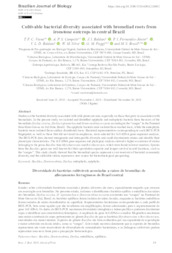Cultivable bacterial diversity associated with bromeliad roots from ironstone outcrops in central Brazil.
Cultivable bacterial diversity associated with bromeliad roots from ironstone outcrops in central Brazil.
Autoria: VIANA, T. F. C.; CAMPELO, A. P. S.; BALDANI, J. I.; FERNANDES JUNIOR, P. I.; BALDANI, V. L. D.; SILVA, W. M.; PAGGI, G. M.; BRASIL, M. S.
Resumo: Studies on the bacterial diversity associated with wild plants are rare, especially on those that grow in association with bromeliads. In the present study, we isolated and identified epiphytic and endophytic bacteria from the roots of the bromeliads Dyckia excelsa, Dyckia leptostachya and Deuterocohnia meziana occurring in the ?cangas? in the Pantanal from Mato Grosso do Sul State, Brazil. The epiphytic bacteria were isolated from washed roots, while the endophytic bacteria were isolated from surface disinfested roots. Bacterial representatives corresponding to each BOX-PCR fingerprint, as well as those that did not result in amplicons, were selected for 16S rDNA gene sequence analysis. The BOX-PCR data showed intrageneric and intraspecific diversity and could discriminate strains and identify their phenotypic characteristics. The 16S rDNA gene sequence and phylogeny analysis showed a higher occurrence of strains belonging to the genus Bacillus than Mycobacterium and Brevibacterium, which were found in lower numbers. Species from the Bacillus genus are well known for their sporulation capacity and longer survival in arid locations, such as the ?cangas?. This study clearly showed that the bromeliad species represent a vast reservoir of bacterial community diversity, and the cultivable strains represent a new source for biotechnological prospecting.
Ano de publicação: 2020
Tipo de publicação: Artigo de periódico
Unidade: Embrapa Semiárido
Palavras-chave: Bacillus (bacteria), Bacillus endophyticus, Bactéria, Bromélia, Diversidade bacteriana, Dyckia, Epiphytic, Planta Silvestre
Observações
1 - Por padrão são exibidas publicações dos últimos 20 anos. Para encontrar publicações mais antigas, configure o filtro ano de publicação, colocando o ano a partir do qual você deseja encontrar publicações. O filtro está na coluna da esquerda na busca acima.
2 - Para ler algumas publicações da Embrapa (apenas as que estão em formato ePub), é necessário ter, no celular ou computador, um desses softwares gratuitos. Sistemas Android: Google Play Livros; IOS: iBooks; Windows e Linux: software Calibre.
Acesse outras publicações
Acesse a Base de Dados da Pesquisa Agropecuária (BDPA) para consultar o acervo completo das bibliotecas da Embrapa.

